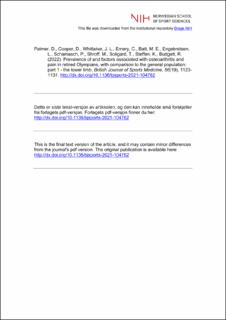| dc.contributor.author | Palmer, Debbie | |
| dc.contributor.author | Cooper, Dale | |
| dc.contributor.author | Whittaker, Jackie L. | |
| dc.contributor.author | Emery, Carolyn | |
| dc.contributor.author | Batt, Mark E | |
| dc.contributor.author | Engebretsen, Lars | |
| dc.contributor.author | Schamasch, Patrick | |
| dc.contributor.author | Shroff, Malav | |
| dc.contributor.author | Soligard, Torbjørn | |
| dc.contributor.author | Steffen, Kathrin | |
| dc.contributor.author | Budgett, Richard | |
| dc.date.accessioned | 2023-01-12T10:00:04Z | |
| dc.date.available | 2023-01-12T10:00:04Z | |
| dc.date.created | 2022-11-02T15:00:12Z | |
| dc.date.issued | 2022 | |
| dc.identifier.citation | British Journal of Sports Medicine. 2022, 56(19), 1123-1131. | en_US |
| dc.identifier.issn | 0306-3674 | |
| dc.identifier.uri | https://hdl.handle.net/11250/3042931 | |
| dc.description | I Brage finner du siste tekst-versjon av artikkelen, og den kan inneholde ubetydelige forskjeller fra forlagets pdf-versjon. Forlagets pdf-versjon finner du på bjsm.bmj.com / In Brage you'll find the final text version of the article, and it may contain insignificant differences from the journal's pdf version. The original publication is available at bjsm.bmj.com | en_US |
| dc.description.abstract | Objectives: This study aims (1) to determine the prevalence of lower limb osteoarthritis (OA) and pain in retired Olympians; (2) to identify factors associated with their occurrence and (3) to compare with a sample of the general population. Methods: 3357 retired Olympians (median 44.7 years) and 1735 general population controls (40.5 years) completed a cross-sectional survey. The survey captured demographics, general health, self-reported physician-diagnosed OA, current joint/region pain and injury history (lasting >1 month). Adjusted OR (aOR) compared retired Olympians with the general population. Results: The prevalence of (any joint) OA in retired Olympians was 23.2% with the knee most affected (7.4%). Injury was associated with increased odds (aOR, 95% CI) of OA and pain in retired Olympians at the knee (OA=9.40, 6.90 to 12.79; pain=7.32, 5.77 to 9.28), hip (OA=14.30, 8.25 to 24.79; pain=9.76, 6.39 to 14.93) and ankle (OA=9.90, 5.05 to 19.41; pain=5.99, 3.84 to 9.34). Increasing age and obesity were also associated with knee OA and pain. While the odds of OA did not differ between Olympians and the general population, Olympians with prior knee and prior hip injury were more likely than controls with prior injury to experience knee (1.51, 1.03 to 2.21 (Olympians 22.0% vs controls 14.5%)) and hip OA (4.03, 1.10 to 14.85 (Olympians 19.1% vs Controls 11.5%)), respectively. Conclusions: One in four retired Olympians reported physician-diagnosed OA, with injury associated with knee, hip and ankle OA and pain. Although overall OA odds did not differ, after adjustment for recognised risk factors Olympians were more likely to have knee and hip OA after injury than the general population, suggesting injury is an occupational risk factor for retired Olympians. | en_US |
| dc.language.iso | eng | en_US |
| dc.title | Prevalence of and factors associated with osteoarthritis and pain in retired Olympians, with comparison to the general population: part 1 - the lower limb | en_US |
| dc.title.alternative | Prevalence of and factors associated with osteoarthritis and pain in retired Olympians, with comparison to the general population: part 1 - the lower limb | en_US |
| dc.type | Peer reviewed | en_US |
| dc.type | Journal article | en_US |
| dc.description.version | acceptedVersion | en_US |
| dc.source.pagenumber | 1123-1131 | en_US |
| dc.source.volume | 56 | en_US |
| dc.source.journal | British Journal of Sports Medicine | en_US |
| dc.source.issue | 19 | en_US |
| dc.identifier.doi | 10.1136/bjsports-2021-104762 | |
| dc.identifier.cristin | 2068194 | |
| dc.description.localcode | Institutt for idrettsmedisinske fag / Department of Sports Medicine | en_US |
| cristin.ispublished | true | |
| cristin.fulltext | postprint | |
| cristin.qualitycode | 2 | |
